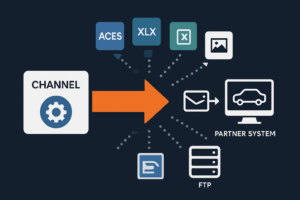What Automotive Brands, Retailers, and Suppliers Need to Know In 2025
California’s Proposition 65 has long presented compliance challenges for automotive manufacturers, parts suppliers, and retailers.
Effective January 1, 2025, the California Office of Environmental Health Hazard Assessment (OEHHA) will enforce new requirements for short-form warning labels—regulations that will require chemical-specific disclosures on products sold in California. While the final deadline to implement new labeling is January 1, 2028, now is the time for automotive brands and supply chain partners to prepare.
This blog breaks down what these changes mean specifically for the automotive industry, outlines the compliance timeline, and provides actionable steps for catalog managers, compliance officers, and aftermarket distributors to maintain alignment with the law while protecting revenue and brand reputation.
Why It Matters to the Automotive Sector
Products sold in California that may expose consumers to substances like lead, phthalates, or other chemicals on the Prop 65 list require a clear and reasonable warning.
Proposition 65 impacts a wide range of automotive products, including but not limited to:
- Interior materials and finishes (e.g., leather treatments, dashboard plastics)
- Electrical components
- Brake pads and rotors
- Tires and rubber parts
- Automotive fluids and battery casings
Products sold in California that may expose consumers to substances like lead, phthalates, or other chemicals on the Prop 65 list require a clear and reasonable warning. Many automotive components are particularly susceptible to triggering warning requirements due to their composition or manufacturing processes.
What’s Changed In 2025?
Beginning January 1, 2025, OEHHA will allow the use of revised short-form warnings
As of January 1, 2028, only these updated warnings will qualify for safe harbor protection on newly manufactured products.
What’s new:
- Chemical-Specific Warnings: Automotive companies must now name at least one Prop 65-listed chemical per risk endpoint (cancer and/or reproductive harm) on product packaging.
- Updated Wording Requirements: Short-form warnings must use phrasing such as:
- “Can expose you to [name of chemical], a [carcinogen/reproductive toxicant].”
- “CA WARNING: Cancer risk from exposure to [chemical]. See www.P65Warnings.ca.gov/auto.”
California-Specific Language Permitted: Labels may use “CA WARNING” or “CALIFORNIA WARNING” to help consumers understand the regulation is California-specific.
Compliance Timeline for Automotive Businesses
| Date | Requirement |
| January 1, 2025 | Use of new short-form labels is permitted. |
| December 31, 2027 | End of transition period. |
| January 1, 2028 | Only updated labels allowed for newly manufactured products. |
Real-World Impact on Automotive Workflows
For the automotive industry, compliance extends beyond labels. Manufacturers, catalog managers, and e-commerce retailers must coordinate across operations to:
- Ensure packaging aligns with OEHHA’s label format.
- Update digital product listings with compliant warnings.
- Work with suppliers to understand which chemicals are present in subcomponents.
- Adjust product information management (PIM) systems to track and surface chemical disclosures at scale.
In an industry where fitment accuracy, safety compliance, and operational transparency are already high-stakes concerns, the new Prop 65 updates add another layer of necessary coordination.
Compliance Checklist for Automotive Brands & Retailers
- Audit Your Product Line: Identify parts, materials, or fluids that may contain listed substances.
- Collaborate With Suppliers: Secure chemical composition disclosures for all sourced components.
- Update Packaging and Labeling: Design new short-form labels with chemical-specific language.
- Review E-Commerce Warnings: Ensure digital storefronts and marketplaces meet OEHHA’s hyperlink and visibility requirements.
- Check Industry-Specific Guidance: OEHHA has issued tailored safe harbor language for automotive parts and vehicles—use these where applicable.
- Implement Systems Support: Leverage supply chain management tools or PIM software to help track compliance.
- Get Legal Guidance: Engage Prop 65 legal experts to avoid risk of lawsuits or enforcement actions.
Early Action Protects Brand Trust and Revenue
In the automotive space, non-compliance can result in more than fines—it can trigger product removals, lost sales opportunities, and long-term brand damage. Lawsuits from private enforcers can be costly and disruptive. Getting ahead of the January 2028 deadline helps reduce risk, control costs, and maintain confidence among California customers.
With penalties reaching $2,500 per violation per day, proactive compliance is a business decision, not just a regulatory necessity.
Learn More
- OEHHA Official Site: www.oehha.ca.gov/prop65.html
- Prop 65 Chemical List: www.P65Warnings.ca.gov/chemicals
- Automotive Warnings Portal: www.P65Warnings.ca.gov/auto



